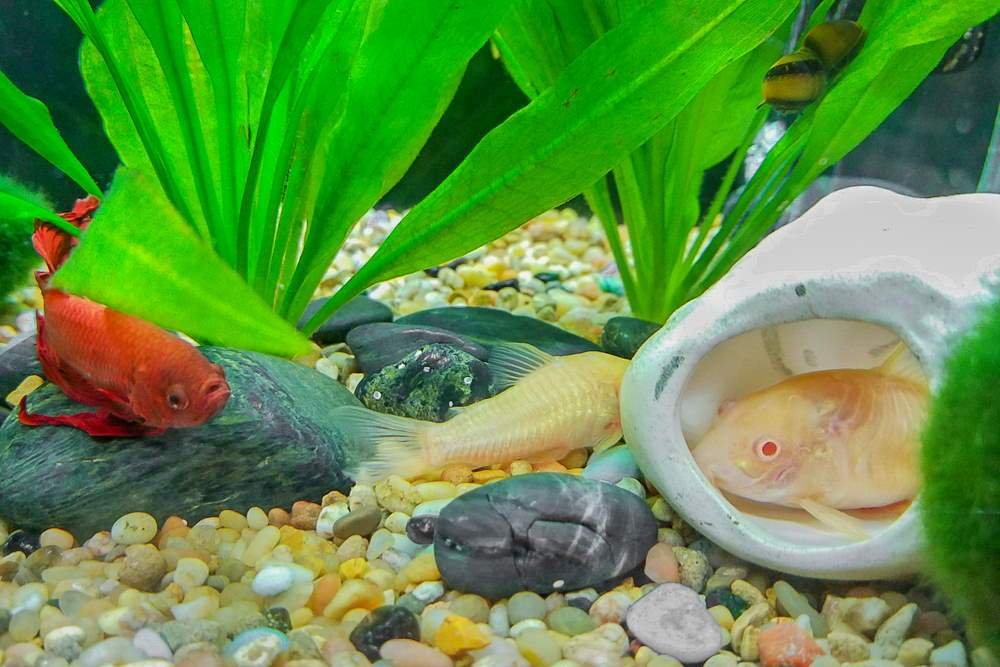
Betta fish, with their vivid colors and flowing fins, are often the centerpiece of home aquariums. While bettas are known for their solitary and sometimes aggressive nature, they can cohabit peacefully with certain tank mates if introduced properly. Preparing your betta for new companions requires careful planning and attention to detail. Here’s a comprehensive guide to help ensure a harmonious environment for your betta and its new tank mates.
1. Understanding Betta Behavior
Solitary Nature: Bettas are naturally territorial, especially males. They have a reputation for aggression towards other fish, particularly those with bright colors and long fins. However, this doesn’t mean they can’t coexist with other species under the right conditions.
Female Bettas: Female bettas are generally less aggressive than males and can often be kept in groups, known as sororities, with careful monitoring.
Choosing the Right Betta: Some bettas are more tolerant of tank mates than others. Observing your betta’s behavior before introducing new fish can help determine if it’s a good candidate for a community tank.
2. Choosing Compatible Tank Mates
Size and Temperament: Select fish that are similar in size or smaller and have a peaceful temperament. Avoid fin-nippers and overly aggressive species.
Suggested Tank Mates:
- Corydoras Catfish: These bottom-dwellers are peaceful and help keep the tank clean.
- Neon Tetras: Small, colorful, and typically non-aggressive, making them good companions.
- Harlequin Rasboras: Peaceful and schooling fish that add movement to the tank.
- Kuhli Loaches: Eel-like fish that are peaceful and spend most of their time hiding.
- Snails and Shrimp: Species like Nerite snails and Amano shrimp can coexist well with bettas.
3. Preparing the Tank Environment
Tank Size: Ensure your tank is large enough to accommodate all inhabitants comfortably. A minimum of 10 gallons is recommended, but larger tanks are better for maintaining stable water conditions and reducing territorial disputes.
Aquascaping: Provide plenty of hiding spots and visual barriers using plants, rocks, and decorations. This helps reduce stress and gives fish places to retreat.
Water Conditions: Maintain optimal water conditions with a stable temperature between 76-82°F, pH levels between 6.5-7.5, and ammonia, nitrite, and nitrate levels as close to zero as possible. Regular water changes and a good filtration system are essential.
4. Introducing New Tank Mates
Quarantine New Fish: Before adding new fish to your tank, quarantine them for at least two weeks. This helps prevent the introduction of diseases and parasites to your established tank.
Gradual Introduction: Use a tank divider or a breeder box to introduce new fish gradually. This allows your betta to get used to the new tank mates without direct contact initially.
Monitor Behavior: Observe your betta and the new fish closely for the first few days. Look for signs of aggression or stress, such as flaring, chasing, or hiding. Be prepared to separate them if necessary.
5. Providing a Balanced Diet
Feeding: Ensure all fish in the tank are getting enough food. Bettas are surface feeders, while some tank mates may feed at different levels. Use a variety of foods suitable for all species present in the tank.
Nutritional Needs: Offer high-quality betta pellets, supplemented with frozen or live foods like brine shrimp and bloodworms. For other fish, provide species-appropriate flakes, pellets, or bottom-feeder tablets.
6. Maintaining a Peaceful Environment
Regular Maintenance: Perform regular water changes and tank cleanings to maintain water quality. Test water parameters frequently to ensure they remain within safe ranges.
Observe Interactions: Continuously monitor the interactions between your betta and its tank mates. Intervene if any fish appear stressed or injured.
Adjustments: Be prepared to make adjustments as needed. This might include rearranging decorations, adding more hiding spots, or even removing certain fish if conflicts arise.
Conclusion
Introducing tank mates to your betta’s environment can be a rewarding experience, adding diversity and activity to your aquarium. However, it requires careful preparation and monitoring to ensure harmony. By understanding your betta’s behavior, choosing compatible companions, creating an optimal environment, and monitoring interactions closely, you can foster a peaceful and thriving community tank. Happy fishkeeping!

